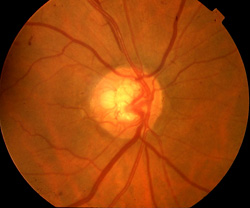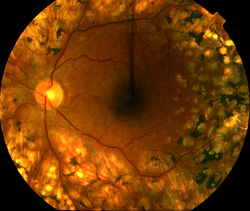Medical treatments for my sight loss so far…
Over the years, I have had a lot of laser treatment for my sight loss to both of my eyes, right from that very first bleed in my right eye. I developed proliferative retinopathy.
- Laser Treatment
- Photodynamic Therapy (PDT)
- Eye Injections
Diabetic retinopathy usually only requires specific treatment when it reaches an advanced stage and there’s a risk to your vision.
1. Laser Treatments for my sight loss
The typical pattern of proliferative retinopathy with laser treatments for my sight loss is:
-
- Have diabetes for a number of years
- Retinal damage occurs
- The retina releases a growth chemical
- New Vessels grow
- Laser treatment is given
- Oxygen and Nutrient flow to the retina improves
- The newly formed vessels close up
- More diabetic damage to the retina
- Even More new vessels grow
- More laser treatment is given
- New Vessels close up
- and the cycle continues until they eventually stop growing
Side effects
After treatment, you may have some side effects for a few hours. These can include:
- blurred vision – you won’t be able to drive until this passes, so you’ll need to arrange for a friend or relative to drive you home, or take public transport
- increased sensitivity to light – it might help to wear sunglasses until your eyes have adjusted
- aching or discomfort – over-the-counter painkillers, such as paracetamol, should help
Possible complications
You should be told about the risks of treatment in advance. Potential complications include:
- reduced night or peripheral (side) vision – some people may have to stop driving as a result of this
- bleeding into the eye or objects floating in your vision (floaters)
- being able to “see” the pattern made by the laser on the back of your eye for a few months
- a small, but permanent, blind spot close to the centre of your vision


The most important part of your treatment is to keep your diabetes under control.
In the early stages of diabetic retinopathy, controlling your diabetes can help prevent vision problems developing.
In the more advanced stages, when your vision is affected or at risk, keeping your diabetes under control can help stop the condition getting worse.
2. Photodynamic therapy (PDT) treatments for my sight loss
What happens during PDT
PDT is carried out in two stages.
1) Preparation
- Usually carried out in an out-patients clinic
- The amount of medication needed is dependant upon your body weight. When the amount has been calculated, it is drawn into a syringe and delivered slowly, through a small cannula into a vein in your hand or arm.
2) Light treatment
- A very strong light (similar to a laser beam) is focussed very carefully onto the specific area that needs to be treated. This is done through a contact lens and the slit lamp. The length of time the light is shone onto the area is very specific.
- The light source activates the medication only in the area that the light is shine onto
After PDT
- You need to avoid sunlight for 48-72 hours. The reason for this is that, as the medication is activated by a light source, it is possible that being in direct sunlight will activate the medication where the sunlight hits your body, therefore causing dangerous burns.
Risks and side effects of PDT
PDT is a very safe treatment, although the following side effects are common:
- a burning or stinging sensation while the light treatment is carried out – this usually passes soon after the treatment finishes
- if the medication was injected, your skin or eyes being sensitive to sunlight and bright indoor lights.
Other potential side effects depend on the area treated.
- A very small risk of permanent vision loss.
3. Eye injections treatments for my sight loss
The treatments for my sight loss involves :
- Numbing drops are placed onto the eyeball
- the skin around the eye is cleaned with iodine and covered with a sterile sheet
- small clips are used to keep the eye open
- a very fine needle is carefully guided into the eyeball and the injection is given
Risks and side effects
Possible risks and side effects of anti-VEGF injections include:
- eye irritation or discomfort
- bleeding inside the eye
- floaters or a feeling of having something in your eye
- watery or dry, itchy eyes
There’s also a risk that the injections could cause blood clots to form, which could lead to a heart attack or stroke. Also increased pressure inside the eye.